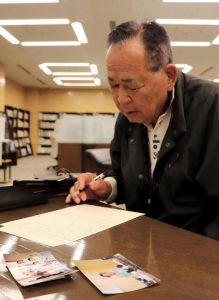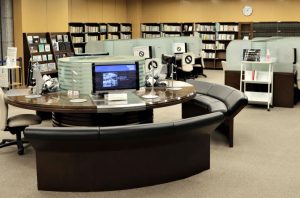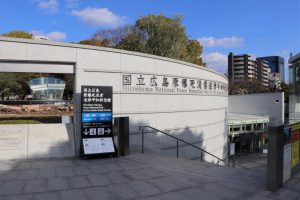Marking its 20th anniversary, Peace Memorial Hall in Hiroshima continues to communicate voices of A-bombing victims
Dec. 26, 2022
by Rina Yuasa, Staff Writer
This year, 2022, marks the 20th anniversary of the opening of the Hiroshima National Peace Memorial Hall for the Atomic Bomb Victims, located in Peace Memorial Park in Hiroshima’s Naka Ward. The memorial hall, a space where victims of the atomic bombing can be mourned and remembered, has conveyed to the public since its beginning the reality of the atomic bombing through the personal accounts of A-bombing experiences and other materials. Nevertheless, many people still are unaware of the facility and the role it plays. Herein, by taking a look back at its background, we will explore the facility’s current status and the challenge it faces.
Most of the hall’s building lies underground. The entrance to the memorial hall is positioned at the bottom of stairs leading to the basement from the ground level, where a clock monument is halted at 8:15, the time the bomb was dropped on the city.
After walking down a sloped decline in the building, as if traveling back in time to August 6, 1945, “that day,” there is a circular room named the “Hall of Remembrance,” where a panoramic photograph of the ruined Hiroshima can be viewed on the wall. On the other side of that room is the “Victim Information Area,” the location where photographs of the atomic bomb victims and a list of their names publicized with consent of the bereaved can be searched and viewed. Further ahead is a library, where survivors’ personal accounts and other materials are archived.
Collection of nearly 150,000 personal accounts
The pillars of the memorial hall’s work are the gathering and making available to the public of personal accounts written by survivors as well as the registering of victims’ photos submitted by family members. In addition to notes written by survivors in a fact-finding survey of A-bomb survivors conducted by the Japanese government every 10 years, the memorial hall also gathers written accounts submitted by survivors and collections of memoirs published by A-bomb survivor organizations. Including personal accounts transcribed by hall staff based on survivors’ oral accounts of the bombing, 148,760 memoirs were archived in the hall as of December 18, 2022.
Looking through the accounts, it can be understood that the devastation caused by the atomic bombing was not limited to only “that day”; in fact, but there was a “Hiroshima” for every one of the many victims.
In the hall, bereaved families sometimes encounter the words of family members who died without recounting their A-bombing experiences, even to family. One such family member was Masaaki Kanaya, 73, of Hiroshima’s centrally located Naka Ward. When he was organizing items left behind by his mother, Kiyoko, who died in the summer of last year, 2021, at the age of 98, he discovered a memo with an illustration in her own hand that described a situation she encountered in the atomic bombing. Mr. Kanaya had never heard the story while his mother was alive. An acquaintance informed him of the memorial hall’s existence as he was trying to find another way to trace his mother’s journey and thoughts.
As it happens, the memorial hall had in its archives a personal account of the atomic bombing submitted by Kiyoko in 1995, in response to the government’s fact-finding survey. “I saw a dead man who was as bright red as a shrimp,” she wrote in a description of a scene that 22-year-old Kiyoko witnessed after experiencing the atomic bombing at a location about 1.6 kilometers from the hypocenter. “I am opposed to war,” she added with a strong stroke of her pen. With tears in his eyes, Mr. Kanaya reacted to what she had written. “It is certainly my mother’s handwriting… She never told us about the atomic bombing even when asked, but she might have wanted to leave behind a record of what she had experienced at the time,” said Mr. Kanaya.
Turning to videos based on survivors’ written notes to increase recognition
With the number of survivors who directly experienced the bombing decreasing with time, the memorial hall’s role of gathering their words and making them accessible to the public grows ever more important.
However, the number of visitors to the memorial hall over the past 20 years is only around 20 percent of the number of visitors to the Hiroshima Peace Memorial Museum, also located in Peace Memorial Park. The memorial hall indicates that many people are unaware of its very existence. With 25,887 photos of victims currently registered, the facility clearly needs to work on increasing the number of visitors.
Recently, the memorial hall has placed an emphasis on its special exhibits, in which are shown 30-minute videos based on personal accounts of A-bomb survivors, along with their photos and related information.
The theme of the 2020 special exhibit was the late Goro Shikoku, an artist who continued communicating to the world his anti-war and anti-nuclear messages through his paintings and poetry from the A-bombed city, as well as his brother who died in the atomic bombing. A video produced for the exhibit took the form of a dialogue between the two based on the diaries of Mr. Shikoku and his brother. In 2021, another special exhibit introduced Jesuit priests who experienced the atomic bombing, and this year, 2022, another such exhibit visualized the words written by the photographers who took photos on August 6, 1945.
Isao Hashimoto, curator in charge of the special exhibits, said, “We want to motivate the imagination of young people through the exhibits so they can imagine what would happen were nuclear weapons to be used again.” The hall’s special exhibition space will be fully renovated to further enhance its visual effectiveness prior to the holding of a new exhibit in March next year, 2023.
The entire staff is engaged in public relations efforts by creating and distributing leaflets of a model sightseeing route, which includes a stop at the facility, for students who visit Hiroshima on school excursions. Masayuki Kubo, director of the memorial hall, explained his own wishes. “My hope is that people deepen their understanding of the devastation resulting from the atomic bombing by visiting the Peace Memorial Museum, where A-bomb artifacts can be observed, as well as the memorial hall, where they can directly feel the words and spirits of the A-bomb survivors through their personal accounts.”
---------------------------------
Some videotaped A-bomb testimonies recorded overseas
The Hiroshima National Peace Memorial Hall for the Atomic Bomb Victims was established by Japan’s national government on August 1, 2002, based on the preamble and articles to the Atomic Bomb Survivors’ Assistance Act, enacted in 1995, which stipulates that “a record be kept of the precious lives lost to the atomic bombing.” The hall gathers photos of the A-bomb victims and the personal accounts of what they experienced and makes the information available to the public, taking on the role of mourning the lives lost in the atomic bombing and conveying the reality of the tragedy throughout the world.
The core of the facility is “The Hall of Remembrance,” a space with an open ceiling in which A-bomb victims can be memorialized. There are also a “Victim Information Area,” where photos of the victims and their names are displayed on a large monitor, and a library, where survivors’ personal accounts can be read.
The memorial hall is managed and operated by the Hiroshima Peace Culture Foundation, an extra-governmental organization affiliated with the Hiroshima City government. In 2005, the memorial hall initiated a project for public readings of personal accounts by volunteers, both in Japanese and English, to communicate more widely the voices of survivors of the personal accounts collected at the facility. In addition to the regular readings held at the hall, the volunteers also visit schools throughout Japan to give readings.
The memorial hall also focuses its efforts on the production of survivor testimonial videos to ensure their experiences are not forgotten and can be passed on to future generations. To this point, a total of 473 testimonial videos have been created, including those of survivors living in eight countries and regions outside of Japan. Some of the videos have been posted on the hall’s website. There are also videos subtitled in 24 different languages.
The memorial hall invites people to register photos and personal accounts of A-bomb survivors. For more information, please contact the memorial hall, at 082-543-6271.
(Originally published on December 26, 2022)
This year, 2022, marks the 20th anniversary of the opening of the Hiroshima National Peace Memorial Hall for the Atomic Bomb Victims, located in Peace Memorial Park in Hiroshima’s Naka Ward. The memorial hall, a space where victims of the atomic bombing can be mourned and remembered, has conveyed to the public since its beginning the reality of the atomic bombing through the personal accounts of A-bombing experiences and other materials. Nevertheless, many people still are unaware of the facility and the role it plays. Herein, by taking a look back at its background, we will explore the facility’s current status and the challenge it faces.
Most of the hall’s building lies underground. The entrance to the memorial hall is positioned at the bottom of stairs leading to the basement from the ground level, where a clock monument is halted at 8:15, the time the bomb was dropped on the city.
After walking down a sloped decline in the building, as if traveling back in time to August 6, 1945, “that day,” there is a circular room named the “Hall of Remembrance,” where a panoramic photograph of the ruined Hiroshima can be viewed on the wall. On the other side of that room is the “Victim Information Area,” the location where photographs of the atomic bomb victims and a list of their names publicized with consent of the bereaved can be searched and viewed. Further ahead is a library, where survivors’ personal accounts and other materials are archived.
Collection of nearly 150,000 personal accounts
The pillars of the memorial hall’s work are the gathering and making available to the public of personal accounts written by survivors as well as the registering of victims’ photos submitted by family members. In addition to notes written by survivors in a fact-finding survey of A-bomb survivors conducted by the Japanese government every 10 years, the memorial hall also gathers written accounts submitted by survivors and collections of memoirs published by A-bomb survivor organizations. Including personal accounts transcribed by hall staff based on survivors’ oral accounts of the bombing, 148,760 memoirs were archived in the hall as of December 18, 2022.
Looking through the accounts, it can be understood that the devastation caused by the atomic bombing was not limited to only “that day”; in fact, but there was a “Hiroshima” for every one of the many victims.
In the hall, bereaved families sometimes encounter the words of family members who died without recounting their A-bombing experiences, even to family. One such family member was Masaaki Kanaya, 73, of Hiroshima’s centrally located Naka Ward. When he was organizing items left behind by his mother, Kiyoko, who died in the summer of last year, 2021, at the age of 98, he discovered a memo with an illustration in her own hand that described a situation she encountered in the atomic bombing. Mr. Kanaya had never heard the story while his mother was alive. An acquaintance informed him of the memorial hall’s existence as he was trying to find another way to trace his mother’s journey and thoughts.
As it happens, the memorial hall had in its archives a personal account of the atomic bombing submitted by Kiyoko in 1995, in response to the government’s fact-finding survey. “I saw a dead man who was as bright red as a shrimp,” she wrote in a description of a scene that 22-year-old Kiyoko witnessed after experiencing the atomic bombing at a location about 1.6 kilometers from the hypocenter. “I am opposed to war,” she added with a strong stroke of her pen. With tears in his eyes, Mr. Kanaya reacted to what she had written. “It is certainly my mother’s handwriting… She never told us about the atomic bombing even when asked, but she might have wanted to leave behind a record of what she had experienced at the time,” said Mr. Kanaya.
Turning to videos based on survivors’ written notes to increase recognition
With the number of survivors who directly experienced the bombing decreasing with time, the memorial hall’s role of gathering their words and making them accessible to the public grows ever more important.
However, the number of visitors to the memorial hall over the past 20 years is only around 20 percent of the number of visitors to the Hiroshima Peace Memorial Museum, also located in Peace Memorial Park. The memorial hall indicates that many people are unaware of its very existence. With 25,887 photos of victims currently registered, the facility clearly needs to work on increasing the number of visitors.
Recently, the memorial hall has placed an emphasis on its special exhibits, in which are shown 30-minute videos based on personal accounts of A-bomb survivors, along with their photos and related information.
The theme of the 2020 special exhibit was the late Goro Shikoku, an artist who continued communicating to the world his anti-war and anti-nuclear messages through his paintings and poetry from the A-bombed city, as well as his brother who died in the atomic bombing. A video produced for the exhibit took the form of a dialogue between the two based on the diaries of Mr. Shikoku and his brother. In 2021, another special exhibit introduced Jesuit priests who experienced the atomic bombing, and this year, 2022, another such exhibit visualized the words written by the photographers who took photos on August 6, 1945.
Isao Hashimoto, curator in charge of the special exhibits, said, “We want to motivate the imagination of young people through the exhibits so they can imagine what would happen were nuclear weapons to be used again.” The hall’s special exhibition space will be fully renovated to further enhance its visual effectiveness prior to the holding of a new exhibit in March next year, 2023.
The entire staff is engaged in public relations efforts by creating and distributing leaflets of a model sightseeing route, which includes a stop at the facility, for students who visit Hiroshima on school excursions. Masayuki Kubo, director of the memorial hall, explained his own wishes. “My hope is that people deepen their understanding of the devastation resulting from the atomic bombing by visiting the Peace Memorial Museum, where A-bomb artifacts can be observed, as well as the memorial hall, where they can directly feel the words and spirits of the A-bomb survivors through their personal accounts.”
---------------------------------
Photos and A-bombing accounts of victims made public by national government
Some videotaped A-bomb testimonies recorded overseas
The Hiroshima National Peace Memorial Hall for the Atomic Bomb Victims was established by Japan’s national government on August 1, 2002, based on the preamble and articles to the Atomic Bomb Survivors’ Assistance Act, enacted in 1995, which stipulates that “a record be kept of the precious lives lost to the atomic bombing.” The hall gathers photos of the A-bomb victims and the personal accounts of what they experienced and makes the information available to the public, taking on the role of mourning the lives lost in the atomic bombing and conveying the reality of the tragedy throughout the world.
The core of the facility is “The Hall of Remembrance,” a space with an open ceiling in which A-bomb victims can be memorialized. There are also a “Victim Information Area,” where photos of the victims and their names are displayed on a large monitor, and a library, where survivors’ personal accounts can be read.
The memorial hall is managed and operated by the Hiroshima Peace Culture Foundation, an extra-governmental organization affiliated with the Hiroshima City government. In 2005, the memorial hall initiated a project for public readings of personal accounts by volunteers, both in Japanese and English, to communicate more widely the voices of survivors of the personal accounts collected at the facility. In addition to the regular readings held at the hall, the volunteers also visit schools throughout Japan to give readings.
The memorial hall also focuses its efforts on the production of survivor testimonial videos to ensure their experiences are not forgotten and can be passed on to future generations. To this point, a total of 473 testimonial videos have been created, including those of survivors living in eight countries and regions outside of Japan. Some of the videos have been posted on the hall’s website. There are also videos subtitled in 24 different languages.
The memorial hall invites people to register photos and personal accounts of A-bomb survivors. For more information, please contact the memorial hall, at 082-543-6271.
(Originally published on December 26, 2022)










